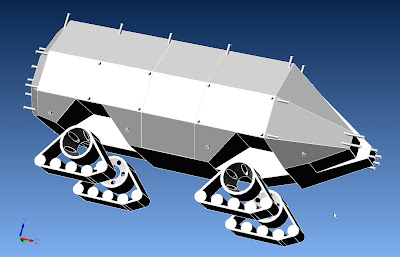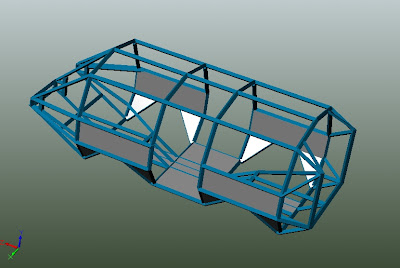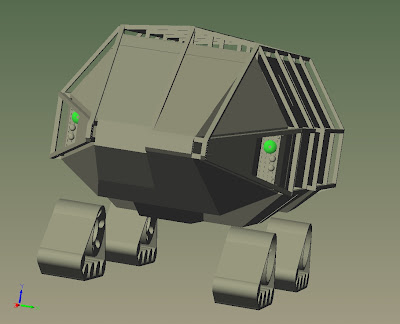
Today I managed to get started on the exoframe. For the image above, I chose the 'Shaded & Visible Edges' view in the CAD program -- now you can plainly see where the side portal is...
The image below shows the rear clearance lights that I added on just to get myself started. Also, you may be able to tell that the first two front-center roof posts are offset to the driver's side, just enough to allow clearance for the front hatch:

I had actually forgotten about that clearance issue the first time around with the roof posts, placing one of them in the center, directly between the side hatches (the glass hatches slide up between the roof and the frame, and require a certain amount of room to do so); It was an easy fix, so no worries.
Next I'll have to figure out how to connect the dots, so to speak. If the resulting visible frame doesn't look beefy enough, remember there is also interior framing. With only the frame represented in these images, EXOVAN is sturdy enough to be driven (though this is not recommended). The bolt-on exterior sections will provide extra cross-bracing and rollover protection, and can be unbolted individually -- to access damaged panels underneath, or to repair or replace the frame sections themselves.
The main reason for these sections to be bolted on rather than welded amounts to a practicality issue in initial construction. If you weld the whole frame up first, good luck getting the body panels on...
You will notice there are no frame protrusions on the bottom of EXOVAN. It's one big skidplate under there -- with panels perhaps twice as thick as on other parts of the body -- allowing EXOVAN to slide over obstacles rather than get hung up on them.
EXOVAN is coming together, and once I'm satisfied enough with this first-draft model I'll grab a capture and Photoshop it for more detail and colour...
Phil Smith
May 8, 2007
Back to the Drawing Board
Shortly after publishing this post, I began the maddening task of attempting to connect the through-body frame stubs with exterior frame sections. Much to my dismay, I found that a couple of key features for this kind of thing are left out of the free version of the 3D CAD program I'm using. At least I got the satisfaction, while browsing through the tutorials, of discovering that I'm already messing around on an 'advanced' level...
I kept at it anyway, enough to see EXOVAN partially clad in exterior framing, but finally called it a night. Went to bed with an inkling of how to finish my model with the (virtual) tools on hand...
...and I've been thinking about it since. What I'll need to do is to go back to an earlier saved version and create all the through-body extrusions all over again, this time with square sections instead of round ones. This will allow me to reposition some of them, and it will give me more flat surfaces -- surfaces to do drawings on, drawings to make extrusions from. Then I can either keep the square tubing or fillet the edges to make it round.
Since it will be better to use square tubing for the interior framing anyway, and since straight cuts will be simpler than round ones on the body panels, all the new through-body extrusions will be left square. That squareness will also come in handy when it's time to make the brackets for bolting exterior sections on.
Cooling still has to be addressed -- yes, even electric vehicles need cooling -- but I have an idea for duct openings that I think will be, um, pretty cool. Plus, they'll provide a mounting point for the headlights. Not sure if I'll do matching ones in the rear, and reposition the taillights into them...
Phil Smith
May 10, 2007
_____













